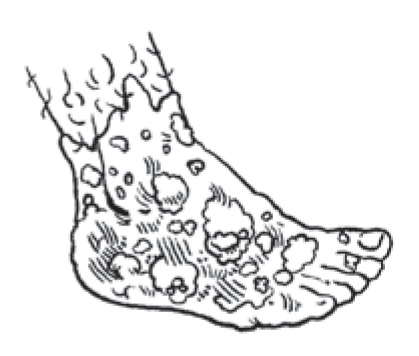I was pretty upset about the foot cramp I had recently—until I recalled my uncle Fig’s surefire old cure, that is! First I soaked my foot in buttermilk overnight. The next morning I brushed it with egg whites, coated it in cornmeal, and lightly seasoned myself from toe to ankle with salt and pepper and just a touch of sage. I am legally prohibited from telling you what I did next, but perhaps we could go over it in a private medium, such as a Facebook chat. Friend me!
The point is, my foot was well on the way to recovery, all thanks to what the old-timers used to call “common sense.” I suppose an egghead in an ivory tower would refer to it as “folkways,” whereas a “new-age healer” would say “homeopathy” and charge you a million dollars for the privilege. Boy, I sure would love to see what Uncle Fig would do if he ever came face to face with some of these big-city beatniks! He’d probably give them a hug and a kiss.
He’s so nice.
Nevertheless, such idle speculations raise a legitimate concern: how much of my family’s traditional wisdom can I reveal, even with the best of intentions, without turning such precious treasure into something crass and commercial?
When I get together with other folksy characters, these types of questions are often the subject of our folksy discussions. When is a nugget of homespun wisdom too personal to use as material? And why did all our grandmothers smoke corncob pipes? Did they really enjoy it, or is it something they saw in a comic strip? Were they trying to be cool?
I was having just such a discussion the other night with a certain tall, languid-voiced purveyor of bucolic tidbits. I don’t want to compromise his privacy, so I’ll call him Barrison Beillor.
Barrison was telling me about the time he got lost in the snow and had to eat three companions in order to survive. “Well, I had to eat two of them,” he drawled.
“You should have spun out some of your wry, homey anecdotes, exactly the way you did just now,” I said. “Then everyone would have been chuckling so warmly that the ice would have melted right off their frostbitten extremities!”
My remark won me a rueful smile, but soon the famous face clouded.
“Today is the birthday of Jack London, who used his own experiences in the Klondike to write vivid, arresting tales of the pitiless domination of nature over man,” Barrison continued in a mournful but lilting cadence. “I could never get away with that brand of story, not in public. Such wonderful, striking details, and I have to keep them to myself. My people are Lutherans. They don’t eat their friends because of a little cold weather. It would be unthinkable, like bringing a three-bean salad out of a can to a covered-dish supper.”
“Cheer up, Barrison,” I said. “You’re not the only one with a right peculiar background.” As evidence, I rolled down my sock and showed him the fragrant coating of cornmeal. As we gazed down, I explained about Uncle Fig and his humble yet efficacious remedies. I wondered aloud how many of them were truly mine to share. By asking for Barrison’s expert opinion, I hoped to pull him out of his gloom. In reply, I heard only the methodical hay-munching of the nearby racehorse that Barrison and I had purchased together with our folksy-wisdom money.
Glancing up, I found to my surprise that Barrison had tied a large, checkered bib around his neck. He held a gigantic spoon in one hand and an equally outsize fork in the other. Staring at my lightly battered foot, he licked his lips.
I’ll admit I was unnerved until he broke the silence: “Here’s a poem for today by W. D. Snodgrass.” His soothing, hypnotic drone let me know everything was going to be all right. In fact, as he recited a series of rhymed couplets about bumblebees, I drifted into a much-needed slumber.
When I awoke, I realized something funny: my foot had stopped hurting!
Garrison Keillor had eaten it and I had gone into shock.





